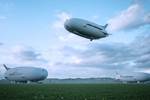HAV launches Airlander Future Networks to explore future Airlander airship variants
Logistics, freight and other key industry players like Kuehne+Nagel and Oregon’s emergency management office are able to contribute industry insights to guide larger Airlander variant design and specification.

Source | Hybrid Air Vehicles (HAV)
(HAV, Bedford, U.K.) has launched the Airlander Futures Network, an initiative to bring together all parties interested in future developments of the Airlander family.
The Airlander Futures Network is a group that enables the logistics, freight and other key markets to come together over shared business needs. These global players will contribute their market expertise and industry insight to drive forward the design and specification of future Airlander aircraft. The Airlander Futures Network builds on learnings from what was the .
“The Airlander Futures Network poses a real opportunity to understand the aspirations of the logistics and freight market,” says George Land, executive director – sales at HAV. “We believe larger Airlander variants can unlock further growth and efficiency in those markets. This network lays the groundwork for relationships with industry that will collaboratively grow to deliver an aircraft that meets their needs and the needs of the planet. We look forward to working with global players to ensure the design of future aircraft meets their requirements.”
HAV acknowledges two members that have joined so far — Kuehne+Nagel (Schindellegi, Switzerland) and the Oregon Department of Human Services’ (ODHS) Office of Resilience and Emergency Management. Kuehne+Nagel, a logistics provider, has joined the network to explore the use of future Airlander variants in its logistics ecosystem, looking specifically at Airlander’s potential to fill the gap between fast, carbon-intensive air freight and cheap but slow surface transport. The ODHS joins to provide expertise and input on the role larger Airlander aircraft could play in humanitarian aid and disaster relief.
Airlander 10, HAV’s first aircraft to market, will be capable of delivering 100-plus seat passenger mobility, or a 10-tonne payload of freight transportation, or a combination of the two. Airlander 10 already has customers, such as European regional airline Air Nostrum Group and eco-tourism brand Grands Espaces. Following this, the Airlander design scales easily into larger variants that could carry up to 200 tonnes. Logistics, freight and disaster relief are key markets for the future Airlander aircraft.
Related Content
-
Low-cost, efficient CFRP anisogrid lattice structures
CIRA uses patented parallel winding, dry fiber, silicone tooling and resin infusion to cut labor for lightweight, heavily loaded space applications.
-
The potential for thermoplastic composite nacelles
Collins Aerospace draws on global team, decades of experience to demonstrate large, curved AFP and welded structures for the next generation of aircraft.
-
First Airbus A350 crash confirmed in Haneda
Shortly after touch-down, a JAL A350-900 aircraft recently collided with a De Havilland Canada Dash 8. Exact circumstances are still unknown.






